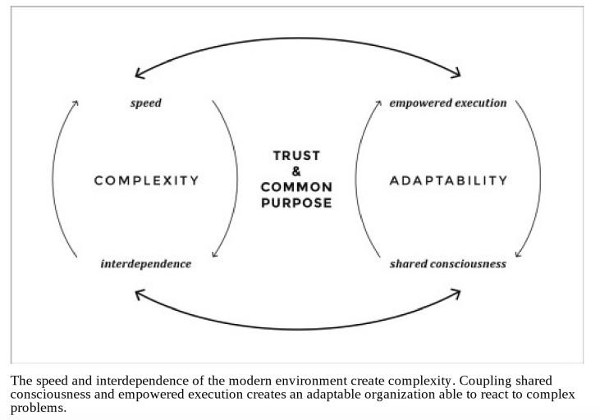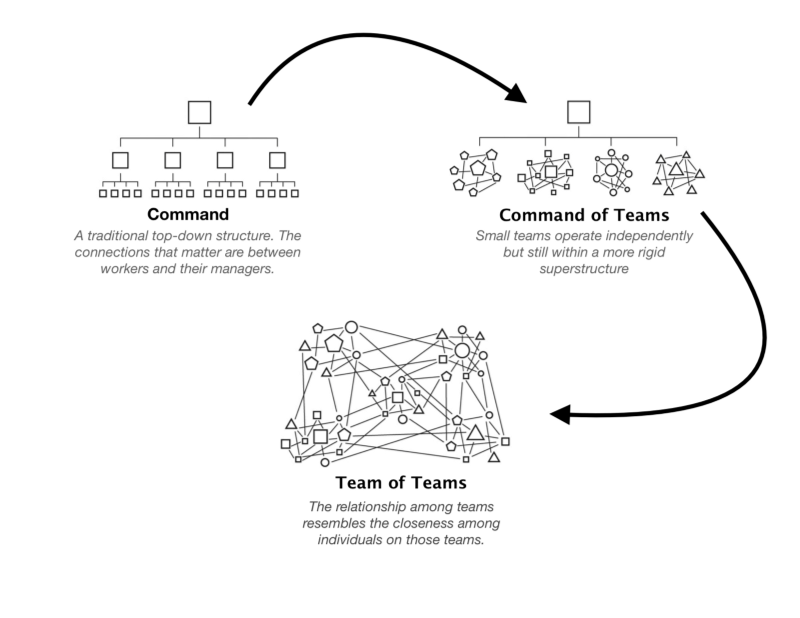Book Club: McChrystal, G. S., Collins, T., Silverman, D., & Fussell, C. (2015). Team of teams: New rules of engagement for a complex world. Penguin.
“Technology and human behaviours have transformed dramatically in the past few decades, but organizations have not kept up. The pace of disruption has become overwhelming and unpredictable” McChrystal Group.
I must admit to having avoided reading this book for some time due to the military aspects but was engaged with the topic from the off. If you want a general summary of the book, check out the GoodReads review, but I will focus on relevance for healthcare using my own ‘biased’ lens. It is essential to look both within and outside industry to find innovations, a silo approach in complex healthcare systems is not a viable approach.
Team of Teams Review
Here are some of the key areas and ideas I found most interesting:
Connected: Are you connected with real connections? How we can talk better and engage?
Interdependence: the need for learning across entire organisations, for a shared consciousness and adaptive organisationsal intelligence.
Interconnectedness: The global landscape with technology provides an evolving and shifting landscape that requires adaptability, agility and connections to make new structures (pg. 26).
Take a look at the “Team of Teams” structure images by McChrystal Group (apologies no free open access were available to use).
Complicated to complex: today’s world with technology and mass of information has increased complexity. How to manage all this ‘real time’ information into meaningful data, action and response is key? How is all this information shared in an organisation, or is it all held by the power in the hierarchical structure?
Agile Structure: the process for rapid iterations to change-assess-change. Importance to not seek the perfect solution (pg. 2). What worked previously may not work again (pg. 5). In education we love the power of evaluation, especially if the results are reaffirming. But are we focusing too much on past events, different situation, different learners and need to revise programs for the future learners rather than past learners?
Adaptability: Is more important for the workforce than efficiency in complex work situations (pg. 7). The team response over individual industrial revolution style efficiency.
“we have to unlearn a great deal……. ” (pg. 20).
Structure: Looked at the behaviours of small units, especially when time spent together in challenging situations and look to bring that close knit team ethos into the wider organisation. Members of different units experienced and joined to form new collaborative teams, in essence ‘to walk in their shoes’ and gain situational awareness of each others importance. These working relationships increased sharing and collaboration in a large organisation.

Change: Less about tactics and technology and more about culture.
Training: ‘train like you fight’ in armed forces using a drill-practice-uniformity-structure approach for standardised and disciplined approach has been followed in healthcare. Policies and checklists provide standardised approaches, simulation allows for rapid cycle training, complex events (especially high risk-low frequency) involving multi-disciplinary team and testing new environments or technology. The question is will the culture, support structures and creativity be trained out of people when unpredictable events occur that need a different approach? Building flexible systems to respond to unknowns through ‘risk adaption training’.
Resilience: “in complex environments, resilience often spells success” (pg. 76). Resilience is very topical in healthcare with burnout, moral distress and compassion fatigue such major issues. How does healthcare tackle ‘resilience’, an approach from a culture perspective is required not just at the individual level.
Technology: “technology had been both a cause of our challenge and a tool for our success. But it was the culture change in the organization that allowed the Task Force to use it properly” (pg. 251).
An important aspect not to miss within the great ‘Team of Team’ hierarchy images is as Sisney (2016) raises that ” the real purpose of any structure – top-down or bottom-up – is not to consolidate or centralize control but to delegate or decentralize authority.” The leader role is not removed, they adapt themselves as part of the team process.
Resources
GoodReads Review of Team of teams: New rules of engagement for a complex world.
McChrystal Group. (2020). Vision & Mission.
Patient Safe. (2017). Team of Teams.
Sisney, L. (2016). Top-down vs. Bottom-up Hierarchy: Or, How to Design a Self-Managed Organization. Organizational Physics.

Leave a Reply